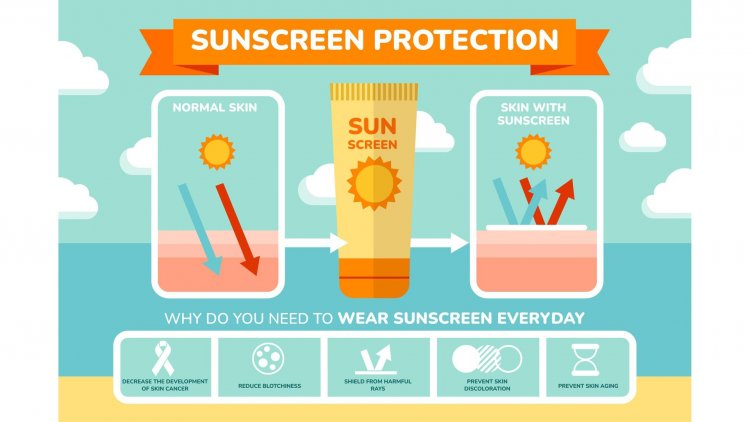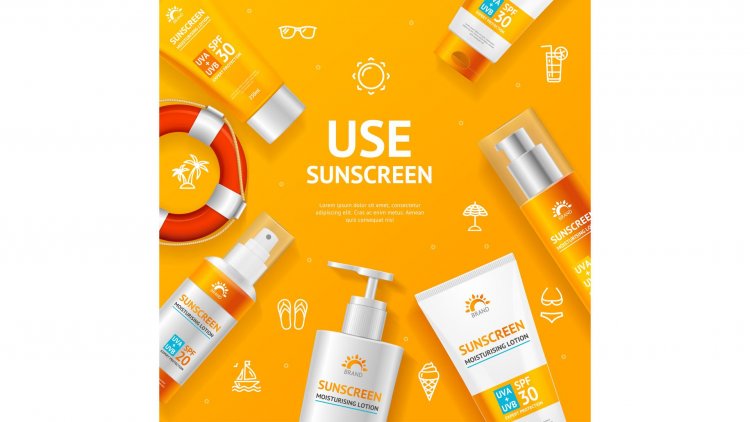The Ultimate Guide to Sunscreen: Finding the Perfect Match for Your Skin
When it comes to skincare, sunscreen is a non-negotiable essential. With the sun’s rays capable of causing everything from premature aging to skin cancer, understanding how to choose the right sunscreen for your skin type is crucial. But with an overwhelming number of products on the market, where do you even start? This guide is designed to demystify sunscreen selection, ensuring you find the perfect fit for your unique skin needs.

Understanding Sunscreen Basics
Before diving into the nuances of selecting the ideal sunscreen, it’s important to understand the basics. Sunscreen primarily works by absorbing, reflecting, or scattering ultraviolet (UV) radiation. There are two main types of UV rays that affect the skin:
- UVA Rays: These rays penetrate deep into the skin and are primarily responsible for photoaging, which includes wrinkles and age spots.
- UVB Rays: These rays affect the outer layer of the skin and are responsible for causing sunburn.
Sunscreens are rated based on their Sun Protection Factor (SPF), which indicates the level of protection they offer against UVB rays. However, SPF does not measure UVA protection, so looking for broad-spectrum sunscreens that protect against both UVA and UVB rays is essential.
Identifying Your Skin Type
To choose the right sunscreen, you first need to identify your skin type. Each type has its own characteristics and requirements, so understanding your skin will help you select a product that offers the best protection without exacerbating any issues.
- Oily and Acne-Prone Skin
If you have oily or acne-prone skin, the last thing you want is a sunscreen that adds to your skin’s oiliness or clogs pores. Opt for sunscreens that are:
- Oil-Free: These formulations help prevent excess oil production and minimize shine.
- Non-Comedogenic: This term indicates that the sunscreen won’t clog pores, reducing the risk of breakouts.
- Gel-Based or Water-Based: Gel-based sunscreens are lighter and absorb quickly, which is ideal for oily skin.
Look for labels that include terms like "oil-free" or "mattifying." Mineral sunscreens with zinc oxide or titanium dioxide are also good options as they tend to be less irritating and less likely to clog pores.
- Dry and Sensitive Skin
Dry and sensitive skin can be more susceptible to irritation and discomfort from certain sunscreens. To avoid exacerbating dryness or causing irritation, choose sunscreens that:
- Contain Hydrating Ingredients: Look for sunscreens with added moisturizers like hyaluronic acid, glycerin, or ceramides.
- Have a Creamy or Lotion Texture: Creams and lotions provide extra moisture and can help soothe dry skin.
- Are Fragrance-Free: Fragrances can irritate sensitive skin, so it’s best to choose products that are free from added scents.
Mineral sunscreens with physical blockers like zinc oxide are often recommended for sensitive skin due to their gentle nature.
- Combination Skin
Combination skin presents a unique challenge as it involves managing both dry patches and oily areas. To cater to this skin type:
- Opt for Lightweight Formulas: Choose sunscreens that are hydrating but not overly greasy.
- Consider Hybrid Products: Some sunscreens offer a balance between hydration and oil control, which can be perfect for combination skin.
- Apply Strategically: Use a bit more product on dry areas and less on oily zones, or use different products for different areas of your face.
Sunscreens with a balanced formula that provides hydration without excessive oil can be particularly effective for combination skin.
- Normal Skin
Normal skin is generally less problematic but still benefits from proper sun protection. For normal skin:
- Choose Broad-Spectrum Protection: Ensure the sunscreen protects against both UVA and UVB rays.
- Consider Your Lifestyle: If you are active or spend a lot of time outdoors, look for water-resistant options.
- Select a Suitable SPF: SPF 30 to 50 is typically sufficient for everyday use.
A broad-spectrum sunscreen with SPF 30 to 50 should be adequate, but personal preferences and lifestyle factors can guide your choice.
Decoding Labels and Ingredients
Understanding sunscreen labels can be overwhelming, but knowing what to look for can simplify your decision-making process. Here’s a breakdown of common terms and ingredients:
SPF Ratings
- SPF 15: Blocks about 93% of UVB rays.
- SPF 30: Blocks about 97% of UVB rays.
- SPF 50: Blocks about 98% of UVB rays.
Higher SPF numbers provide slightly more protection, but no sunscreen can block 100% of UVB rays.
Broad-Spectrum Protection
This term means that the sunscreen protects against both UVA and UVB rays. This is crucial for comprehensive sun protection and preventing long-term skin damage.
Water-Resistant vs. Waterproof
- Water-Resistant: This means the sunscreen maintains its SPF protection for 40 to 80 minutes while swimming or sweating.
- Waterproof: No sunscreen is truly waterproof; the term is not used on labels anymore due to FDA regulations.
Reapply sunscreen every two hours or immediately after swimming or sweating, regardless of water resistance.
Key Ingredients
- Physical (Mineral) Sunscreens: Contain zinc oxide or titanium dioxide and are ideal for sensitive skin. They work by reflecting UV rays away from the skin.
- Chemical Sunscreens: Include ingredients like avobenzone, octocrylene, and octinoxate. They absorb UV radiation and convert it into heat, which the skin then releases.
Both types have their benefits, so choosing between them often comes down to personal preference and skin sensitivity.
Navigating Lifestyle and Environmental Factors
Selecting the right sunscreen also involves considering your lifestyle and environmental factors. Your daily activities and the environment you live in can significantly impact the effectiveness of your sunscreen and its suitability for your skin type.
- Lifestyle Considerations
Your lifestyle can dictate the kind of sunscreen that will work best for you:
- Active Lifestyle: If you are frequently outdoors or engage in sports, opt for water-resistant or sports-specific sunscreens. These are formulated to withstand sweat and water, providing longer-lasting protection during physical activities.
- Urban Living: For those who spend most of their time indoors or in urban settings, a daily moisturizer with SPF may suffice. These are typically lighter and designed for everyday wear, offering protection against incidental sun exposure.
- Travelers: If you travel frequently or are exposed to varying climates, consider sunscreens that come in travel-friendly packaging or multipurpose products that combine sun protection with other benefits, like hydration or anti-aging.
- Environmental Factors
Your environment can also affect your choice of sunscreen:
- High Altitude: At higher elevations, UV radiation is stronger due to thinner atmospheric layers. If you live or spend time at high altitudes, use sunscreens with higher SPF and consider reapplying more frequently.
- Tropical Climates: In areas with intense sun exposure and high humidity, opt for sunscreens that are water-resistant and non-greasy to avoid feeling sticky and to ensure the sunscreen stays on in humid conditions.
- Cold Weather: In cold climates, UV exposure can still be significant, especially if there is snow, which reflects UV rays. Use a hydrating sunscreen to combat dry, cold air while ensuring adequate protection.
Application Tips for Maximum Effectiveness
Choosing the right sunscreen is just the beginning; proper application is key to ensuring you get the full benefits. Here’s how to apply sunscreen effectively:
- Apply Generously: Most people don’t use enough sunscreen. Apply about a nickel-sized amount for your face and a shot glass-sized amount for your body.
- Apply Before Sun Exposure: For best results, apply sunscreen about 15 to 30 minutes before going outside. This allows the sunscreen to fully absorb and create a protective barrier on your skin.
- Reapply Regularly: Reapply sunscreen every two hours or immediately after swimming, sweating, or towel drying. Even if your sunscreen is labeled as water-resistant, reapplication is crucial.
- Don’t Forget Areas: Be sure to apply sunscreen to often-missed areas like the back of your neck, ears, and the tops of your feet. Areas often exposed to the sun should never be neglected.

Incorporating Sunscreen into Your Daily Routine
Integrating sunscreen into your daily routine ensures you’re always protected from harmful UV rays. Here’s how to make it a habit:
- Morning Routine: Apply sunscreen as the final step of your morning skincare routine. If using a separate sunscreen, apply it after your moisturizer and before any makeup.
- Makeup and Sunscreen: If you wear makeup, choose a foundation or powder with SPF to boost your protection. However, it’s still important to use a dedicated sunscreen as your base layer.
- Sunscreen for the Whole Family: Ensure everyone in your household is protected. For children, use sunscreens specifically designed for sensitive skin and reapply often, especially if they are swimming or playing outdoors.
Choosing the Best Sunscreen for Different Needs
To summarize the key points:
- Oily or Acne-Prone Skin: Go for oil-free, non-comedogenic, and gel-based sunscreens.
- Dry or Sensitive Skin: Opt for hydrating, fragrance-free, and creamy sunscreens.
- Combination Skin: Choose lightweight formulas or use different products for different areas.
- Normal Skin: A broad-spectrum sunscreen with SPF 30 to 50 should be sufficient.
By understanding your skin type, environmental factors, and how to apply sunscreen effectively, you can better protect yourself from the harmful effects of UV radiation.
With the right sunscreen and proper application, you’ll be well on your way to maintaining healthy, protected skin year-round. Remember, sun protection is not just about avoiding sunburn; it’s about preserving your skin’s health and preventing long-term damage.
Disclaimer
The information provided in this article is for educational purposes only and should not be considered medical advice. If you have any health concerns or are experiencing symptoms, it is important to consult with a healthcare professional, such as a doctor or clinic, for proper diagnosis and treatment. Always seek the advice of your doctor or other qualified health provider with any questions you may have regarding a medical condition. Do not disregard professional medical advice or delay in seeking it because of something you have read in this article.
What's Your Reaction?





















